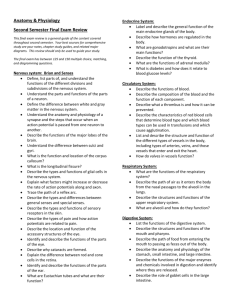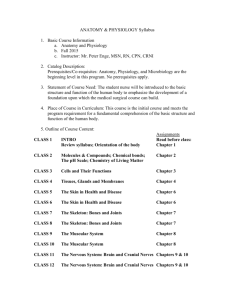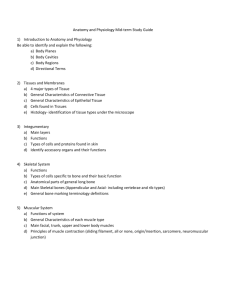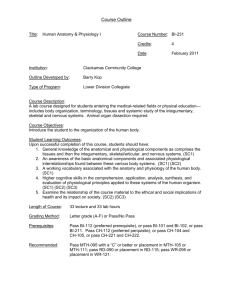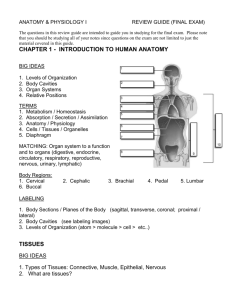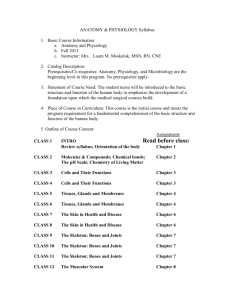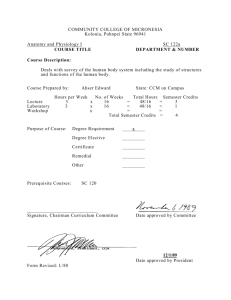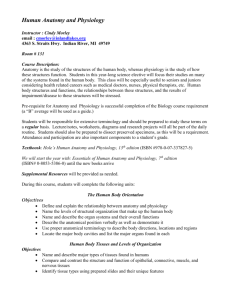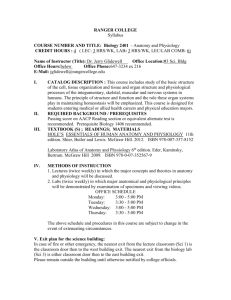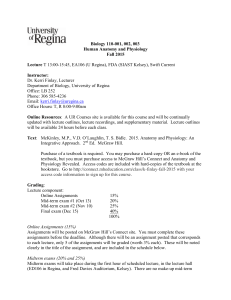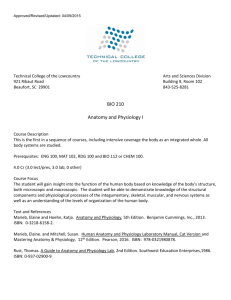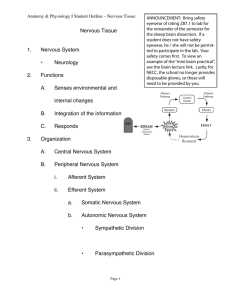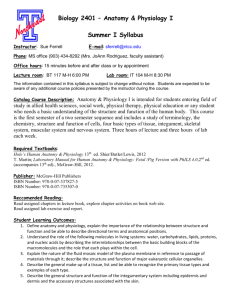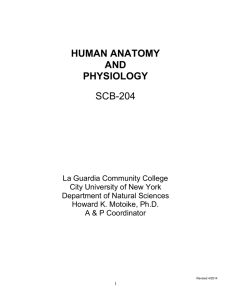BIO 137-
advertisement
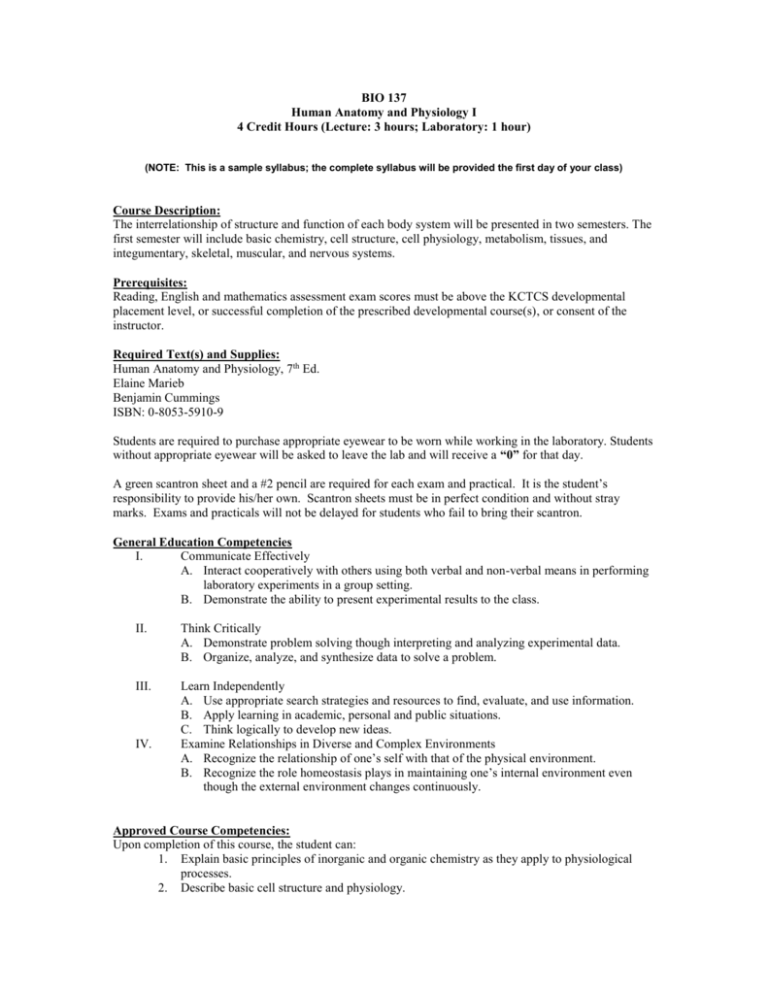
BIO 137 Human Anatomy and Physiology I 4 Credit Hours (Lecture: 3 hours; Laboratory: 1 hour) (NOTE: This is a sample syllabus; the complete syllabus will be provided the first day of your class) Course Description: The interrelationship of structure and function of each body system will be presented in two semesters. The first semester will include basic chemistry, cell structure, cell physiology, metabolism, tissues, and integumentary, skeletal, muscular, and nervous systems. Prerequisites: Reading, English and mathematics assessment exam scores must be above the KCTCS developmental placement level, or successful completion of the prescribed developmental course(s), or consent of the instructor. Required Text(s) and Supplies: Human Anatomy and Physiology, 7th Ed. Elaine Marieb Benjamin Cummings ISBN: 0-8053-5910-9 Students are required to purchase appropriate eyewear to be worn while working in the laboratory. Students without appropriate eyewear will be asked to leave the lab and will receive a “0” for that day. A green scantron sheet and a #2 pencil are required for each exam and practical. It is the student’s responsibility to provide his/her own. Scantron sheets must be in perfect condition and without stray marks. Exams and practicals will not be delayed for students who fail to bring their scantron. General Education Competencies I. Communicate Effectively A. Interact cooperatively with others using both verbal and non-verbal means in performing laboratory experiments in a group setting. B. Demonstrate the ability to present experimental results to the class. II. Think Critically A. Demonstrate problem solving though interpreting and analyzing experimental data. B. Organize, analyze, and synthesize data to solve a problem. III. Learn Independently A. Use appropriate search strategies and resources to find, evaluate, and use information. B. Apply learning in academic, personal and public situations. C. Think logically to develop new ideas. Examine Relationships in Diverse and Complex Environments A. Recognize the relationship of one’s self with that of the physical environment. B. Recognize the role homeostasis plays in maintaining one’s internal environment even though the external environment changes continuously. IV. Approved Course Competencies: Upon completion of this course, the student can: 1. Explain basic principles of inorganic and organic chemistry as they apply to physiological processes. 2. Describe basic cell structure and physiology. 3. 4. 5. 6. 7. 8. Describe the structure and function of major tissue types. Recognize the complementarity of structure and function. Describe basic metabolic processes of organ systems. Explain the interrelationships between organ systems and physiological processes. Explain the major homeostatic mechanisms utilized in each body system in response to internal and external environmental changes. Explain physiological and anatomical mechanisms of common dysfunctions. Course Structure: This course is designed to assist students in learning anatomy and physiology through detailed lecture and practical laboratory exercises. Course Outline: I. Chemistry of life A. Inorganic molecules important in physiological processes B. Basic atomic structure C. Ion formation D. Chemical bonding 1. Ionic 2. Covalent 3. Hydrogen E. pH and buffering 1. Sodium bicarbonate/carbonic acid 2. Sodium monohydrogen/dihydrogen phosphates 3. Proteins 4. Hemoglobin F. Organic functional groups G. Organic compounds 1. Carbohydrates 2. Lipids 3. Proteins 4. Nucleic acids 5. ATP H. Hydrolysis and dehydration synthesis I. Solutions II. Anatomical Terminology A. Directional terminology B. Body systems C. Body planes and sections D. Body cavities E. Body regions III. Eukaryotic Cell Structure and Function A. Cellular organelles and their functions B. Cell membrane structure C. Transport D. Enzymes E. Cell division 1. Mitosis 2. Meiosis IV. Metabolism A. The function of ATP B. Oxidation/reduction reactions C. ATP formation 1. Glycolysis 2. Krebs cycle 3. Electron transport chain V. VI. VII. VIII. IX. D. Role of glycerol, fatty acids and amino acids in the metabolic mill E. Protein synthesis Animal Tissues A. Epithelial B. Muscular C. Connective D. Nervous Integumentary System A. Functions B. Layers of the skin C. Accessory structures D. Membranes Skeletal System A. Functions B. Macroscopic anatomy of bone C. Microscopic anatomy of bone tissue D. Intramembranous bone formation E. Endochondral bone formation F. Growth and repair G. Articulations 1. Classes of joints 2. Synovial joint structure H. Identification of major bones and markings Muscular System A. Functions B. Characteristics of muscles C. Microscopic structure of muscle tissue 1. Muscle fibers 2. Myofibrils D. Physiology of muscle contraction E. Energy sources for muscle contraction F. Types of muscle contraction G. Movements H. Identification Nervous System A. Functions B. Divisions of the nervous system C. Anatomy of nervous tissue 1. Neurons 2. Neuroglial cells D. Physiology of nerve impulses E. Synapses and neurotransmitters F. Spinal cord 1. Gray and white matter 2. Ascending and descending tracts 3. Spinal nerves G. Spinal reflexes H. Brain 1. Cerebral cortex 2. Brain stem 3. Cerebellum 4. Cranial nerves I. Autonomic nervous system 1. Sympathetic 2. Parasympathetic J. Sensory receptors and organs 1. 2. 3. 4. 5. Skin and muscles Ear Eye Nose Tongue Laboratory Exercises: Osteology 1 (Lower Extremities/Spine) Bony Landmarks 1 Osteology 2 (Upper Extremities/Skull) Bony Landmarks 2 Histology Basic Culturing Basic Microscopy Slide Preparation Nervous System Lab Brain Lab Cranial Nerves Rhine/Weber Otoscope/Ophthalmoscope Eye Dissection

